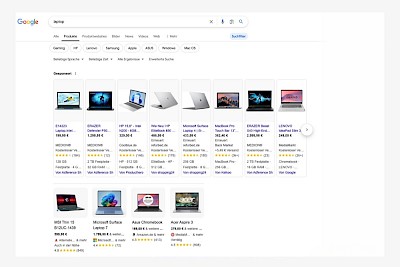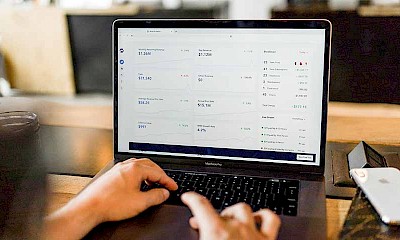
Set up Google Shopping & increase conversions
How to set up Google Shopping and benefit from the advantages
With a market share of over 90 percent, Google is the most popular search engine in Germany. Thanks to the constantly improving algorithm, users are shown suitable search results more and more efficiently. Since 2013, the search engine has also been competing with marketplaces such as Amazon in the area of transactional search queries. Users searching for items are shown suitable offers from advertising retailers directly in the search results - either above the organic search results with the "Sponsored" label or in the shopping tab. This not only increases sales figures, but also the brand awareness of the companies.

What is Google Shopping?
Google Shopping is an online service that enables retailers to advertise their own products in the search engine using suitable search terms. With the product presentation in the search results, providers can draw attention to their products and lead potential customers to their online store. For example, if a user enters the term "laptop" in the search bar, a selection of suitable products from various providers is suggested directly in the results before the organic search results are displayed. These so-called display ads are paid advertisements placed by providers.
Costs of Google Shopping
Since 2020, the display of products in the Shopping tab has been free of charge. If you want to place additional advertising there or in the search results, you can do so for a fee. This allows higher ad placements to be achieved.
How does Google Shopping work?
Ad design
Where a Shopping ad is displayed depends on various factors such as bids, relevance to the search term and user activity. The latter is derived from the information that users disclose in their Google accounts as well as from previous search queries and website visits by Google partners.
Playout
Shopping campaigns are activated automatically, whereby you have no direct influence on the search queries for which your ad groups are displayed. This is based solely on the product information provided by the retailer. Careful titling, description and categorization is therefore important. However, retailers can exclude irrelevant keywords by using so-called negative keywords to prevent inappropriate ad placements.
Cost structure
Shopping campaigns are billed using the CPC model (cost-per-click). This means that you only pay for your ads if they are clicked on by users. The price per click is based on the popularity and therefore the competition for a keyword. To control spending, you can set a daily budget that defines the maximum amount you are willing to spend on your campaign each day. This helps with effective budget management and ensures that costs do not increase unexpectedly. When setting the daily budget, retailers should consider ROAS (Return on Advertising Spend), which measures the relationship between advertising spend and the resulting revenue. An effectively managed daily budget or bidding strategy focused on ROAS will allow you to optimize your investments and maximize the profitability of your Shopping campaigns.

Products tab
The Products tab under the search bar shows special shopping results. Product ads from retailers that are listed on Google Shopping and match user queries are presented here. The tab provides a user-friendly overview of products with images, prices, ratings and other details. Users can filter, compare and buy items directly.

Shopping ads
Google Shopping ads, based on linked data from the Merchant Center, show product images, prices and product-based information in search results and in the Shopping tab. They appear for matching user searches and lead directly to the merchant's landing page for the purchase with a click.
3 good reasons why companies should use Google Shopping
Even though you should create your Google Shopping ads carefully and with caution, running Shopping campaigns requires relatively little effort compared to other advertising measures. All desired items can be easily entered and advertised at the same time.
Millions of people use the search engine every day to find the right products for them. By being present in Google Shopping, you can therefore present your goods to a large audience and reach potential (new) customers who are actively searching for your items. The prominent placement of product ads in the search results increases the chances that users will click on the ads and complete the purchase.
Google Shopping offers targeted advertising options. By using keywords and targeting options, you can aim your ads at a specific target group. Your ads will only be shown to users who are actually interested in your products. Targeting allows you to use your marketing budget more efficiently and achieve a higher conversion rate.
Does Google Shopping also offer advantages for my customers?
With an increasing number of online retailers and a growing range of goods and services, the search for the perfect offer is becoming more and more difficult. Many customers are often looking for a specific product, but are open-minded about the manufacturer or brand and are more price-conscious. By setting up Google Shopping and presenting your product range via the Shopping tab or in ads, you present your customers with the solution to their problem on a silver platter.
Would you like to place your products easily and successfully? We would be happy to get to know you in a non-binding initial consultation!

Set up Google Shopping: This is how it works
A Google account is a prerequisite for using Google Shopping. If you do not yet have one, you must first set up an account.
Step 1: Create a Google Ads account & set up conversion tracking
First, store operators - if they do not yet have an account - must register with Google Ads. It is then advisable to set up conversion tracking in order to track how effective the advertising campaigns are and what direct influence they have on sales or other desired user actions.
Step 2: Creating & setting up a Google Merchant Center account
You can easily set up your Google Merchant Center via the Google Ads account you have created. To do this, select the Merchant Center in the service planner under Settings and enter all the missing data. The setup is free of charge.
What is the Google Merchant Center?
The Merchant Center is a platform that allows merchants to upload and manage items for Google Shopping. It serves as a central interface through which merchants can enter product information, upload images, set prices and specify other relevant details. It ensures that the uploaded product information meets the requirements of the search engine and is structured correctly. It is possible to upload Excel files or tables to automatically complete the product data feed. It also allows retailers to monitor the performance of their products, manage stock levels and set up promotional campaigns.
Step 3: Creating the data feed
In order to enter your items, at least one item with all product-based data must be submitted to the search engine. The following product identifiers are required for transmission:
Depending on how many products you want to display via Google Shopping, various transmission options are possible:
- Manual upload of individual products
- Use Google spreadsheets to automatically upload product data feeds
- Upload the data feed via a locally saved file (transfer via FTP, cloud or similar)
- Content API
- Crawling structured product data in your own store system and account link with Google
Note: Make sure that you do not simply copy your product descriptions and metadata from your website when entering them. This will prevent your Google Shopping entries and products from your online store from duplicating each other and getting in each other's way in the rankings. If you need support with this, we are happy to assist you as an experienced SEO agency and Google Shopping agency.
Step 4: Setting up Google Shopping Ads
Google Shopping Ads are created and managed via Google Ads. If you have created your Merchant Center account directly and do not yet have an Ads account, you must create an account now at the latest and link it to your Merchant Center in order to have access to your product portfolio.
Shopping campaigns have been run with Performance Max since September 2022. This campaign type is AI-based and controls your Google Shopping campaign fully automatically. Part of this control is, for example, the bidding strategy, which is automatically optimized by Performance Max based on your campaign goals and available budget.
You provide PMax with assets such as ad titles, descriptions, texts and images as well as your products via the Merchant Center or another CSS and PMax takes care of creating and displaying your ads. You must make certain campaign settings to be able to influence the control and restrict the ad placement to the Shopping channel.
- Disable the function "Extension of the final URL" and do not enter a URL. This prevents the automatic adjustment of the stored page according to search intent.
- Only add assets for the channel on which your ads are to be displayed.
Google Shopping and SEO
Although search engine advertising with Google Shopping (SEA) and search engine optimization (SEO) appear to have nothing to do with each other at first glance, there are synergies between paid and organic advertising measures. This is because the listing of products automatically increases the awareness of a retailer, which in turn benefits SEO. Increasing brand awareness usually results in more organic search queries and more website visitors are generated via regular searches.

4 tips for successful Google Shopping
Meaningful titles
Use up to 150 characters effectively for your title. Include important product data, keywords and the brand name first to stand out from the competition and attract the right customers.
Keywords to exclude
In the Merchant Center, you can exclude unwanted keywords, such as other brand names, to avoid being associated with them.
Relevant search terms
In Google Shopping campaigns, the addition of targeted keywords in titles and descriptions is essential. They help your ads to be found by the right users, which can increase click-through rates and sales opportunities.
High quality product images
Professional images are central to your ads. They create a strong first impression, increase customer confidence and present the item effectively by showing it from different perspectives and in high resolution.
For whom is paid Google Shopping worthwhile?
Google Shopping is generally beneficial for all online retailers and a variety of product categories, especially in markets with intense competition. However, they can be less effective in niche areas with few competitors, as the search engine may show ads less frequently or not at all in such cases due to the lack of relevant competition and search volume.

Maximize sales with DREIKON
Are you looking for an effective way to advertise your products online? With Google Shopping, we bring your products right in front of the eyes of your target group. As an experienced e-commerce agency, we support you in being present exactly where your customers shop. We look forward to getting to know you in a non-binding initial consultation.











